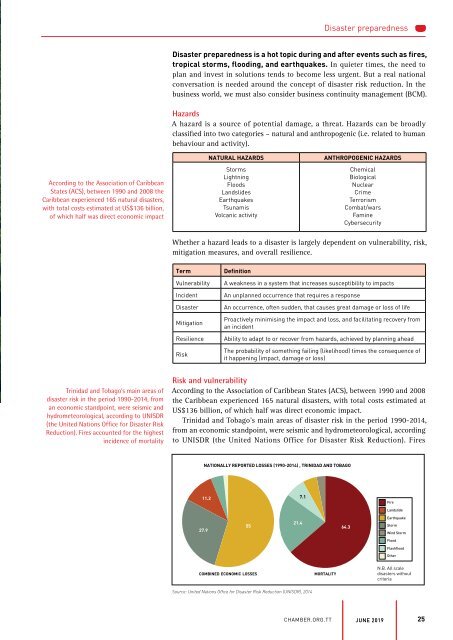CONTACT Magazine (Vol.19 No. 2 – June 2019)
The fifth issue of the rebranded CONTACT Magazine — with a brand new editorial and design direction — produced by MEP Publishers for the Trinidad & Tobago Chamber of Industry & Commerce
The fifth issue of the rebranded CONTACT Magazine — with a brand new editorial and design direction — produced by MEP Publishers for the Trinidad & Tobago Chamber of Industry & Commerce
Create successful ePaper yourself
Turn your PDF publications into a flip-book with our unique Google optimized e-Paper software.
Disaster preparedness<br />
Disaster preparedness is a hot topic during and after events such as fires,<br />
tropical storms, flooding, and earthquakes. In quieter times, the need to<br />
plan and invest in solutions tends to become less urgent. But a real national<br />
conversation is needed around the concept of disaster risk reduction. In the<br />
business world, we must also consider business continuity management (BCM).<br />
Hazards<br />
A hazard is a source of potential damage, a threat. Hazards can be broadly<br />
classified into two categories <strong>–</strong> natural and anthropogenic (i.e. related to human<br />
behaviour and activity).<br />
According to the Association of Caribbean<br />
States (ACS), between 1990 and 2008 the<br />
Caribbean experienced 165 natural disasters,<br />
with total costs estimated at US$136 billion,<br />
of which half was direct economic impact<br />
NATURAL HAZARDS<br />
Storms<br />
Lightning<br />
Floods<br />
Landslides<br />
Earthquakes<br />
Tsunamis<br />
Volcanic activity<br />
ANTHROPOGENIC HAZARDS<br />
Chemical<br />
Biological<br />
Nuclear<br />
Crime<br />
Terrorism<br />
Combat/wars<br />
Famine<br />
Cybersecurity<br />
Whether a hazard leads to a disaster is largely dependent on vulnerability, risk,<br />
mitigation measures, and overall resilience.<br />
Term<br />
Vulnerability<br />
Incident<br />
Disaster<br />
Mitigation<br />
Resilience<br />
Risk<br />
Definition<br />
A weakness in a system that increases susceptibility to impacts<br />
An unplanned occurrence that requires a response<br />
An occurrence, often sudden, that causes great damage or loss of life<br />
Proactively minimising the impact and loss, and facilitating recovery from<br />
an incident<br />
Ability to adapt to or recover from hazards, achieved by planning ahead<br />
The probability of something failing (likelihood) times the consequence of<br />
it happening (impact, damage or loss)<br />
Trinidad and Tobago’s main areas of<br />
disaster risk in the period 1990-2014, from<br />
an economic standpoint, were seismic and<br />
hydrometeorological, according to UNISDR<br />
(the United Nations Office for Disaster Risk<br />
Reduction). Fires accounted for the highest<br />
incidence of mortality<br />
Risk and vulnerability<br />
According to the Association of Caribbean States (ACS), between 1990 and 2008<br />
the Caribbean experienced 165 natural disasters, with total costs estimated at<br />
US$136 billion, of which half was direct economic impact.<br />
Trinidad and Tobago’s main areas of disaster risk in the period 1990-2014,<br />
from an economic standpoint, were seismic and hydrometeorological, according<br />
to UNISDR (the United Nations Office for Disaster Risk Reduction). Fires<br />
NATIONALLY REPORTED LOSSES (1990-2014) , TRINIDAD AND TOBAGO<br />
11.2<br />
7.1<br />
Fire<br />
Landslide<br />
27.9<br />
55<br />
21.4<br />
64.3<br />
Earthquake<br />
Storm<br />
Wind Storm<br />
Flood<br />
Flashflood<br />
Other<br />
COMBINED ECONOMIC LOSSES<br />
MORTALITY<br />
N.B. All scale<br />
disasters without<br />
criteria<br />
Source: United Nations Office for Disaster Risk Reduction (UNISDR), 2014<br />
chamber.org.tt JUNE <strong>2019</strong><br />
25


















